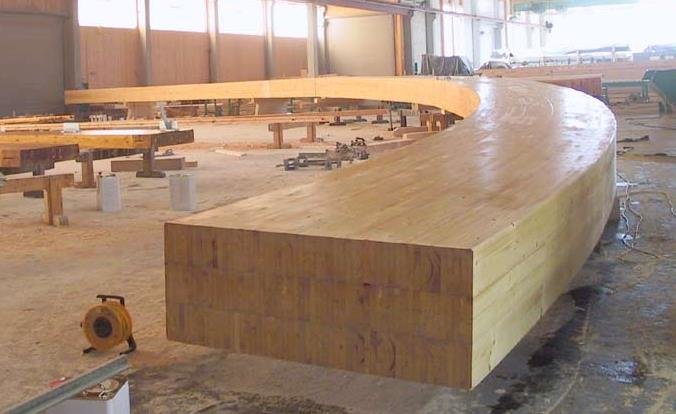Glulam vs. LVL: A Comprehensive Guide
by Admin
Posted on 09-09-2024 10:17 AM

November 26, 2021
by borjen yeh, phd, pe
laminated veneer lumber (lvl) and glue-laminated timber (
glulam
) products are designed for applications where they will be highly stressed under design loads.
 Drilling or notching of lvl and glulam should typically be avoided. However, in situations where it is not possible, these guidelines should be followed. Glulam timber beams
glulam beams are manufactured with lower-grade material in the mid-depth of the beam and higher-grade material positioned on the top and bottom. The highest grade of material is used as the outermost laminations on the tension side of the beam. Due to this, any drilling, dapping (countersinking), or notching taking place in these outermost tension laminations affects the strength and serviceability of the beam.
Drilling or notching of lvl and glulam should typically be avoided. However, in situations where it is not possible, these guidelines should be followed. Glulam timber beams
glulam beams are manufactured with lower-grade material in the mid-depth of the beam and higher-grade material positioned on the top and bottom. The highest grade of material is used as the outermost laminations on the tension side of the beam. Due to this, any drilling, dapping (countersinking), or notching taking place in these outermost tension laminations affects the strength and serviceability of the beam.
The decision between glulam and lvl depends on various factors, including project requirements, design considerations, and budget constraints. Here are a few guidelines to consider: span and load requirements: glulam excels in long-span applications and heavy-load situations. If your project demands wide spans or needs to support substantial loads without intermediate supports, glulam might be the preferred choice. Consistency and predictability: lvl’s uniform properties make it an excellent option for applications where consistent performance is crucial, such as engineered beams and headers. Architectural design: if your project requires custom shapes, curves,
or unique architectural features, glulam’s flexibility in manufacturing allows for greater design possibilities.Comparison Between Glulam vs LVL
Now two commonly used engineered wood products for construction are glulam (glued laminated timber) and lvl (laminated veneer lumber). Now we will explore the features, benefits and uses of these two types of woods lvl and glulam. So that you can make an informed decision in using the wood for your construction.
 First let’s understand these two types of woods before making a comparison.
First let’s understand these two types of woods before making a comparison.
Mass timber is a term that covers a range of timber products and represents a relatively new approach to both residential and commercial building in new zealand. Unlike traditional light-frame construction (timber frames and joists – nzs3604 method), which are primarily nailed together and assembled onsite over multiple days, mass timber is generally manufactured off-site and is typically lifted into place within hours of arriving onsite. Key building components can include large, solid wood panels, columns or beams, forming load bearing walls, floors, and roofs. But what is the difference between these products? new zealand has a number of manufacturers who are creating products that fit within the mass timber category.
Which is Better Glulam or LVL?
Wood is one of the most versatile and widely used materials in construction, known for its strength, durability, and sustainability.
laminated veneer lumber (lvl) is an engineered wood product that uses multiple layers of thin wood assembled with adhesives. It is typically used for headers , beams , rimboard , and edge-forming material. Lvl offers several advantages over typical milled lumber : made in a factory under controlled specifications, it is stronger, straighter, and more uniform. Due to its composite nature, it is much less likely than conventional lumber to warp, twist, bow, or shrink. Lvl is a type of structural composite lumber, comparable to glued laminated timber (glulam) but with a higher allowable stress. A high performance more sustainable alternative to lumber, laminated veneer lumber (lvl) beams, headers and columns are used in structural applications to carry heavy loads with minimum weight.
No matter the size, we have varying widths and depths of glulams to suit your project. Pound-for-pound, these economical beams, headers and columns are lighter and stronger than steel, lvl and psl. Get a quote.